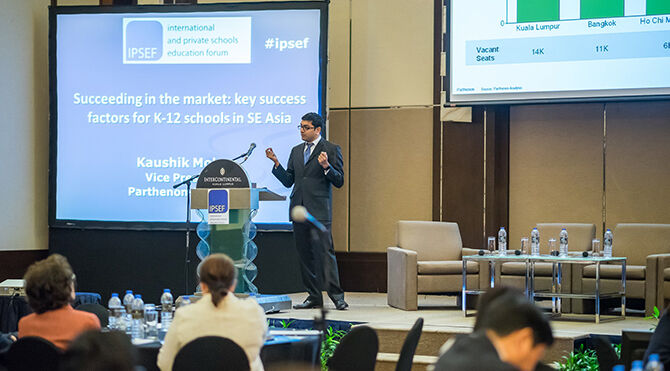Examining international school growth in Asia at the IPSEF conference
A recent report by ISC Research shows that the number of international schools in East Asia has grown by 32 per cent in four years. In Southeast Asia the figure rises to 39 per cent over the same time period.

Number of premium, English-medium international schools in East and Southeast Asian countries:
| Rank | Country | Number of International Schools |
| 1 | China | 567 |
| 2 | Japan | 257 |
| 3 | Indonesia | 190 |
| 4 | Thailand | 181 |
| 5 | Hong Kong | 177 |
| 6 | Malaysia | 170 |
| 7 | Cambodia | 114 |
| 8 | Vietnam | 111 |
| 9 | Singapore | 110 |
| 10 | South Korea | 93 |
| 11 | Philippines | 61 |
| 12 | Myanmar | 46 |
| 13 | Taiwan | 31 |
| 14 | Laos | 9 |
| 15 | Brunei | 8 |
Related news:
- Farewell Marie Curie: Why are young women turned off STEM?
- International Baccalaureate offers career-related learning in Kent
- Malvern College launches new Hong Kong school
Across the Southeast Asian region, student enrollment in international schools has gone up by 33.9 per cent in the last four years, with Malaysia and Thailand leading the pack. China continues to dominate the whole of East and Southeast Asia, however, with 234,424 students enrolling in premium English-medium international schools, nearly four times as many as Hong Kong, which is second in the rankings.
Countries in East and Southeast Asia with highest number of student enrollment in premium, English-medium international schools:
| Rank | Country | Student Enrollment |
| 1 | China | 232,424 |
| 2 | Hong Kong | 79,853 |
| 3 | Malaysia | 71,589 |
| 4 | Thailand | 64,928 |
| 5 | Singapore | 63,789 |
| 6 | Indonesia | 57,402 |
| 7 | Japan | 54,848 |
| 8 | Vietnam | 40,003 |
| 9 | South Korea | 31,201 |
| 10 | Cambodia | 26,188 |
| 11 | Philippines | 24,355 |
| 12 | Taiwan | 14,115 |
| 13 | Myanmar | 13,179 |
| 14 | Brunei | 6,255 |
| 15 | Laos | 3,374 |
IPSEF
Sami Yosef, head of South East Asia research at ISC Research, will present the very latest data and intelligence on the developments and opportunities for international school investment in East and Southeast Asia at the conference. He will announce more country-specific data and intelligence at IPSEF.South Africa’s Curro Group will also be presenting various models for developing low-cost, yet high quality education fit for emerging markets in Cambodia, Vietnam, the Philippines and Myanmar.Teacher recruitment will also be a key issue at the conference, as recruiting top talent has always been a great challenge for many international schools, with key presentations on teacher retention and global recruitment and placement of teachers.Further information on the conference programme and registration details may be obtained from www.ipsef.net.For related news and features, visit our Education and Schools section.Access hundreds of global services and suppliers in our Online Directory Get access to our free Global Mobility Toolkit
Get access to our free Global Mobility Toolkit 






































